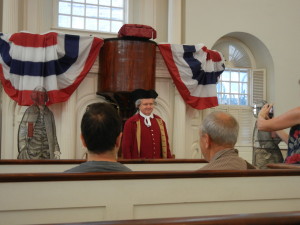Americans like to remember the American Revolution as a Patriot movement, but are they hostile to the memory and viewpoints of Loyalists? Check out Parts 2 & 3 of my 3-post series: "Searching for Loyalists: Boston Harborfest," which appeared in the Journal of the American Revolution.
 "No Tax on Tea! A Colonial Tea Debate” (Part 2)
"No Tax on Tea! A Colonial Tea Debate” (Part 2)
On Friday July 5, I returned to the Old South Meeting House for the “No Tax on Tea! A Colonial Tea Debate” program. Unlike “Whispers of Revolution: Plotting the Boston Tea Party,” this event invited audience members to “[assume] the role of a Patriot or Loyalist to debate the tax on tea!” A Meeting House docent handed each visitor a blue or yellow piece of paper. The slips contained the name and occupation of a colonial Bostonian and their position on the Tea Act. Blue papers described Patriot positions, yellow pieces Loyalist positions.
A museum educator began the program by setting the scene. On December 16, 1773, Patriots and Loyalists gathered at the Old South Meeting House to debate whether they should unload the cargoes of the three tea ships anchored in Boston Harbor or send them back to England fully loaded. The assembled colonists chose Samuel Savage of Weston, Massachusetts to moderate the meeting. A re-enactor playing Savage ascended the pulpit stairs.
Click here to continue reading.
 "Tory Stories" (Part 3)
"Tory Stories" (Part 3)
After attending the “No Tax on Tea!” program at the Old South Meeting House, I walked to nearby King’s Chapel, the first Anglican Church in Massachusetts.[1] The steeple-less, hand-hewn, granite-block church sits on the edge of Boston’s first burial ground. In 1686, Governor Edmund Andros thwarted the Puritans’ refusal to sell land to non-Puritans by using eminent domain to take part of the public burial ground for the construction of King’s Chapel. In 1749, the Chapel’s congregation commissioned Peter Harrison of Newport, Rhode Island to design a new, stone church to replace the wooden chapel Andros built. The church has always been steeple-less, at first because the congregation lacked the funds to build one, and later, because the steeple-less façade had become a defining feature of the church.[2]
During Harborfest, King’s Chapel staff offers “Tory Stories.” The program consists of two female re-enactors; one portrays Baroness Agnes Frankland (née Surriage), the Marblehead, Massachusetts barmaid who married Sir Charles Henry (“Harry”) Frankland, Baronet and the other plays Lady Margaret Gage (née Kemble), wife of Lieutenant-General Thomas Gage.[3] In the 1770s, both women worshipped at King’s Chapel. Together, Ladies Frankland and Gage regaled visitors with tales of the most famous King’s Chapel congregants.
Click here for "Tory Stories."


